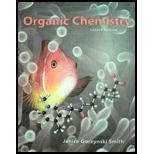
Concept explainers
(a)
Interpretation: The given species are to be arranged in order of increasing nucleophilicity.
Concept introduction: The replacement or substitution of one functional group with another different functional group in any
Answer to Problem 7.54P
The order of increasing nucleophilicity is
Explanation of Solution
On moving right to left across a row in periodic table, nucleophilicity as well as the basicity increases. Therefore, the order of increasing nucleophilicity is
The order of increasing nucleophilicity is
(b)
Interpretation: The given species are to be arranged in order of increasing nucleophilicity.
Concept introduction: The replacement or substitution of one functional group with another different functional group in any chemical reaction is termed as substitution reaction. In nucleophilic substitution reaction, nucleophile takes the position of leaving group by attacking on the electron deficient carbon atom. The good nucleophiles are strong base whose conjugate acids have high
Answer to Problem 7.54P
The order of increasing nucleophilicity is
Explanation of Solution
The size of
The order of increasing nucleophilicity is
(c)
Interpretation: The given species are to be arranged in order of increasing nucleophilicity.
Concept introduction: The replacement or substitution of one functional group with another different functional group in any chemical reaction is termed as substitution reaction. In nucleophilic substitution reaction, nucleophile takes the position of leaving group by attacking on the electron deficient carbon atom. The good nucleophiles are strong base whose conjugate acids have high
Answer to Problem 7.54P
The order of increasing nucleophilicity is
Explanation of Solution
A solvent in which hydrogen atom is bonded to electronegative
The order of increasing nucleophilicity is
(d)
Interpretation: The given species are to be arranged in order of increasing nucleophilicity.
Concept introduction: The replacement or substitution of one functional group with another different functional group in any chemical reaction is termed as substitution reaction. In nucleophilic substitution reaction, nucleophile takes the position of leaving group by attacking on the electron deficient carbon atom. The good nucleophiles are strong base whose conjugate acids have high
Answer to Problem 7.54P
The order of increasing nucleophilicity is
Explanation of Solution
The nucleophilicity and basicity are directly related to each other in
On moving down the group in a periodic table and left to right in a period, basicity decreases and hence, nucleophilicity decreases. Sulfur lies below oxygen atom and nitrogen lies left to oxygen atom in a periodic table. Thus, the order of increasing nucleophilicity is
The order of increasing nucleophilicity is
(e)
Interpretation: The given species are to be arranged in order of increasing nucleophilicity.
Concept introduction: The replacement or substitution of one functional group with another different functional group in any chemical reaction is termed as substitution reaction. In nucleophilic substitution reaction, nucleophile takes the position of leaving group by attacking on the electron deficient carbon atom. The good nucleophiles are strong base whose conjugate acids have high
Answer to Problem 7.54P
The order of increasing nucleophilicity is
Explanation of Solution
The nucleophilicity and basicity are directly related to each other in polar aprotic solvent. Acetone is a polar aprotic solvent.
On moving down the group in a periodic table and left to right in a period, basicity decreases and hence, nucleophilicity decreases. Chlorine lies below fluorine atom and nitrogen lies left to fluorine in a periodic table. Thus, the order of increasing nucleophilicity is
The order of increasing nucleophilicity is
(f)
Interpretation: The given species are to be arranged in order of increasing nucleophilicity.
Concept introduction: The replacement or substitution of one functional group with another different functional group in any chemical reaction is termed as substitution reaction. In nucleophilic substitution reaction, nucleophile takes the position of leaving group by attacking on the electron deficient carbon atom. The good nucleophiles are strong base whose conjugate acids have high
Answer to Problem 7.54P
The order of increasing nucleophilicity is
Explanation of Solution
A solvent in which hydrogen atom is bonded to electronegative
The order of increasing nucleophilicity is
Want to see more full solutions like this?
Chapter 7 Solutions
Organic Chemistry - With Access (Custom)
- HCOO- > HO- > (CH3)2 Sort from best nucleophile to worst nucleophilearrow_forwardWhat is the locant of the methoxy substituent? 4-methoxy 1-methoxy 5-methoxy 3-methoxyarrow_forwardRank the nucleophiles in each group in order of increasing nucleophilicity. a.−OH, −NH2, H2O b.−OH, Br−, F− (polar aprotic solvent) c.H2O, −OH, CH3CO2−arrow_forward
- Complete the following reaction: Pb+2 + SO4 -2 ---------------arrow_forwardRank the species in each group in order of increasing nucleophilicity.a. CH3CH2S-, CH3CH2O-, CH3CO2- in CH3OHb. CH3NH2, CH3SH, CH3OH in acetonec. -OH, F-, Cl- in acetoned. HS-, F-, Cl- in CH3OHarrow_forwardWhy is Ch3coo- a better nucleophile than OH-?arrow_forward
- Which is the better leaving group in each pair?a. Cl-, I-b. NH3, -NH2c. H2O, H2Sarrow_forwardCan you match best nucleophile / conditions that will give a successful hydrolysis reaction for each electrophile? 1. Acid chloride 2. Acetic anhydride 3. Ester 4. Amide a. LiAlH4; hydronium work-up b. PCC c. NaH d. CrO3 e. HOEt f. H3O+ or OH- g. H2O h. NaBH4;hydronium work-uparrow_forwardWhat is the reagent in this reaction? a. mCPBA, water, H+ b. H2, Pd c. NaBH4, water d. KMNO4arrow_forward
- Would you say its sn1 ir sn2, I said it was sn1,because the nucleophile is weak, but my teachers said it was sn2arrow_forwardOptions for each: blank 1: A B blank 2: it has a better leaving group it is a polar aprotic solvent it has a stronger nucleophile blank 3: A B blank 4: it forms a more stable carbocation it has a better solvent it has a better leaving group blank 5: A B blank 6: it has a better solvent it has a better leaving group it has a stronger nucleophilearrow_forwardFill in the missing reagents in the boxes below. some steps may require more than one step.arrow_forward
 Organic Chemistry: A Guided InquiryChemistryISBN:9780618974122Author:Andrei StraumanisPublisher:Cengage Learning
Organic Chemistry: A Guided InquiryChemistryISBN:9780618974122Author:Andrei StraumanisPublisher:Cengage Learning
